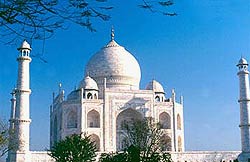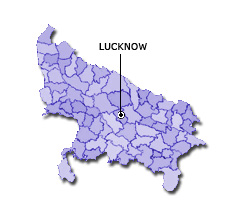Uttar Pradesh (Lucknow)
| Particulars | Description |
|---|---|
 Area Area |
2,40,928 sq. km |
 Population Population |
19,95,81,477 * |
 Capital Capital |
Lucknow |
 Principal Languages Principal Languages |
Hindi and Urdu |
History and Geography
The history of Uttar Pradesh is very ancient and interesting. It is recognised in the later Vedic Age as Brahmarshi Desha or Madhya Desha. Many great sages of the Vedic times like Bhardwaja, Gautam, Yagyavalkaya, Vashishtha, Vishwamitra and Valmiki flourished in this state. Several sacred books of the Aryans were also composed here. Two great epics of India, Ramayana and Mahabharata, appear to have been inspired by Uttar Pradesh.
In the sixth century B.C., Uttar Pradesh was associated with two new religions - Jainism and Buddhism. It was at Sarnath that Buddha preached his first sermon and laid the foundations of his order, and it was in Kushinagar in Uttar Pradesh, where Buddha breathed his last. Several centres in Uttar Pradesh like Ayodhya, Prayag, Varanasi and Mathura became reputed centres of learning. In the medieval period, Uttar Pradesh passed under Muslim rule and led the way to new synthesis of Hindu and Islamic cultures. Ramananda and his Muslim disciple Kabir, Tulsidas, Surdas and many other intellectuals contributed to the growth of Hindi and other languages.
Uttar Pradesh preserved its intellectual excellence even under the British administration. The British combined Agra and Oudh into one province and called it United Provinces of Agra and Oudh. The name was shortened to the United Provinces in 1935. In January 1950 the United Provinces was renamed as Uttar Pradesh.
The State is bound by Uttarakhand and Himachal Pradesh in the north, Haryana in the west, Madhya Pradesh in the South and Bihar in the east. Uttar Pradesh can be divided into two distinct regions (i) Southern Hills and (ii) Gangetic Plain.
Agriculture
Agriculture is the main occupation of 66 per cent of the population of the State. The net cultivated area in the state is 164.17 lakh hectares.
Industry and Minerals
There were 6,12,338 Small Scale Industries with involving a total investment of 7172 crore, as per earlier records.
Under the public sector, mining of limestone, magnesite, coal, rock phosphate, dolomite and silicon-sand is carried out. The bulk production of minor and some of the major minerals like limestone, silica-sand, magnesite, pyrophyllite and diaspore is mostly with the private sector. Important mineral based industries include large cement plants in Sonebhadra.
Irrigation and Power
UP Power Corporation, UP State Power Generation and UP Hydel Power Corporation had been formed by reorganising UP State Electricity Board on 14 January 2000.
During 2001-02 the total installation capacity was 4659 MW, in 2006-07 it was 5011 MW which has now been raised up to 5077 MW. During the year 2001-02 the total power production was 226330 lakh KW and in the year 2006-07 it was 229692 which at present 227099 during the year 2007-08. The total consumption of power during the year 2001-02 was 253301 lakh KW.
Power is an important input to accelerate the process of economic growth. The installed capacity of re-organized Uttar Pradesh during Tenth Five Year Plan was 7821.82 MW. Only 56.6 per cent of 97135 villages were electrified and 7.88 lakh private tubewells were energised. At the time of inception the total installed capacity of UPSEB, including thermal and hydro, was 2,635 MW which has now been raised to 5414 MW (derated 5,885.75 MW).
Transport
Roads: The total road length of PWD in the State is 146728 km. This includes 3820 km of national highways, 8391 km of state highways, 119726 of other district roads and 134517 km of rural roads.
Railways: Lucknow is the main junction of the northern network. Other important railway junctions are Agra, Kanpur, Allahabad, Mughalsarai, Jhansi, Moradabad, Varanasi, Tundla, Gorakhpur, Gonda, Faizabad, Bareilly and Sitapur.
Aviation: There are airports at Lucknow, Kanpur, Varanasi, Allahabad, Agra, Jhansi, Bareilly, Hindon (Ghaziabad), Gorakhpur, Sarsawa (Saharanpur) and Fursatganj (Rae-Barelli).
Festivals

Kumbh Mela, Allahabad
The biggest congregation, perhaps of the world, Kumbha Mela is held at Allahabad every twelfth year and Ardh kumbh Mela every sixth year. Magh Mela is also held at Allahabad in January when the people come in large number to have a dip in the holy Sangam.
Among other fairs is the fortnight long Jhoola fair of Mathura, Vrindavan and Ayodhya, when dolls are placed in gold and silver jhoolas or cradles. A dip in the Ganga on Kartik Poornamasi is supposed to be the holiest and there are big congregations at Garhmukteshwar, Soran, Rajghat, Kakora, Bithur, Kanpur, Allahabad, Varanasi and Ayodhya. A famous cattle fair is held at Bateswar in Agra district.
Dewa in Barabanki district has became famous because of the Muslim saint Waris Ali Shah. Besides, important festivals of the Hindus, Muslims, etc., are widely celebrated in the State.
Tourist Centres

Taj Mahal, Agra
Uttar Pradesh has varied attractions for all kinds of tourists. Besides ancient places of pilgrimage like Varanasi, Vindhyachal, Ayodhya, Chitrakoot, Prayag, Naimisharanya, Mathura, Vrindavan, Dewa Sharief, Dargah of Sheikh Saleem Chisti in Fatehpur Sikri, Sarnath, Shravasti, Kushinagar, Sankisa, Kampil, Piprahwa and Kaushambi, places like Agra, Ayodhya, Sarnath, Varanasi, Lucknow, Jhansi, Gorakhpur, Jaunpur, Kannauj, Mahoba, Devgarh, Bithur, and Vindhyachal have rich treasures of Hindu and Islamic architecture and culture.
* As per 2011 Census (Provisional Data)
States and Capitals
Union Territories
* S (Summer) and * W (Winter)

